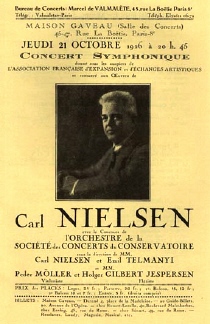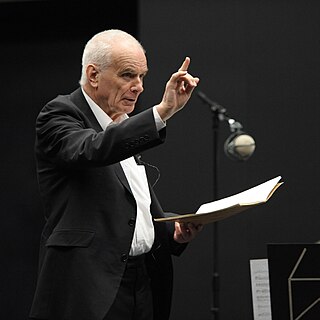
A symphony is an extended musical composition in Western classical music, most often for orchestra. Although the term has had many meanings from its origins in the ancient Greek era, by the late 18th century the word had taken on the meaning common today: a work usually consisting of multiple distinct sections or movements, often four, with the first movement in sonata form. Symphonies are almost always scored for an orchestra consisting of a string section, brass, woodwind, and percussion instruments which altogether number about 30 to 100 musicians. Symphonies are notated in a musical score, which contains all the instrument parts. Orchestral musicians play from parts which contain just the notated music for their own instrument. Some symphonies also contain vocal parts.

Carl August Nielsen was a Danish composer, conductor and violinist, widely recognized as his country's most prominent composer.
Robert Wilfred Levick Simpson was an English composer, as well as a long-serving BBC producer and broadcaster.

The Symphony No. 1 in F minor, Op. 10, by Dmitri Shostakovich was written in 1924–1925, and first performed in Leningrad by the Leningrad Philharmonic under Nicolai Malko on 12 May 1926. Shostakovich wrote the work as his graduation piece at the Petrograd Conservatory, completing it at the age of 19.
Sergei Prokofiev's Symphony-Concerto in E minor, Op. 125 is a large-scale work for cello and orchestra.
Symphony No. 6 "Sinfonia semplice",, FS 116. In August 1924 Danish composer Carl Nielsen began working on a Sixth Symphony, which turned out to be his last. By the end of October he wrote to Carl Johan Michaelsen:
As far as I can see, it will on the whole be different from my other symphonies: more amiable and smooth, or how shall I put it, but it is impossible to tell as I do not know at all what currents I may run into during the voyage.

Symphony No. 5, Op. 50, FS 97 is a symphony composed by Carl Nielsen in Denmark between 1920 and 1922. It was first performed in Copenhagen on 24 January 1922 with the composer conducting. It is one of two of Nielsen's six symphonies lacking a subtitle, the other being his Symphony No. 1.
Walter Sinclair Hartley was an American composer of contemporary (classical) music.
Symphony No. 4, Op. 29, FS 76, also known as "The Inextinguishable", was completed by Danish composer Carl Nielsen in 1916. Composed against the backdrop of the First World War, this symphony is among the most dramatic that Nielsen wrote, featuring a "battle" between two sets of timpani.
Symphony No. 1 in G minor, Op. 7, FS 16 is the first symphony of Danish composer Carl Nielsen. Written between 1891 and 1892, it was dedicated to his wife, Anne Marie Carl-Nielsen. The work's première, on 14 March 1894, was performed by Johan Svendsen conducting the Chapel Royal Orchestra, with Nielsen himself among the second violins. It is one of two symphonies by Nielsen without a subtitle.
Symphony No. 2 De fire Temperamenter, "The Four Temperaments", Op. 16, FS 29 is the second symphony by Danish composer Carl Nielsen, written in 1901–1902 and dedicated to Ferruccio Busoni. It was first performed on 1 December 1902 for the Danish Concert Association, with Nielsen himself conducting. As indicated in the subtitle, each of its four movements is a musical sketch of a humor of the four temperaments: choleric, phlegmatic, melancholic, and sanguine. Despite its apparent concept of program music, the work is a fully integrated symphony in traditional symphonic structure.
Robert Simpson composed his Symphony No. 11 in 1990, dedicating the work to the conductor and composer Matthew Taylor, who was scheduled to give the premiere at Cheltenham Town Hall with the City of London Sinfonia on 15 July 1991. However, this event never took place, and the actual premiere was given at the Malvern Festival in 1992, by the same performers.

Carl Nielsen's Concerto for Flute and Orchestra was written in 1926 for Holger Gilbert-Jespersen, who succeeded Paul Hagemann as flautist of the Copenhagen Wind Quintet. The concerto, in two movements, was generally well received at its premiere in Paris in October 1926 where Nielsen had introduced a temporary ending. The first complete version was played in Copenhagen the following January. The flute concerto has become part of the international repertoire.

Carl Nielsen's Wind Quintet, or as indicated by the original score, the Kvintet for Flöte, Obo, Klarinet, Horn og Fagot, Op. 43, was composed early in 1922 in Gothenburg, Sweden, where it was first performed privately at the home of Herman and Lisa Mannheimer on 30 April 1922. The first public performance was on 9 October 1922 in the smaller hall at the Odd Fellows Mansion in Copenhagen. It is considered a staple of the repertoire for wind quintet.

The Sinfonia Concertante for Four Winds in E-flat major, K. 297b, is a work thought to be by Wolfgang Amadeus Mozart for oboe, clarinet, horn, bassoon, and orchestra. He originally wrote a work for flute, oboe, horn, bassoon, and orchestra, K. Anh. 9 (297B), in Paris in April 1778. This original work is lost.

The Symphony No. 2 by Peter Maxwell Davies was commissioned by the Boston Symphony Orchestra in celebration of its centenary, and was composed in 1980. Seiji Ozawa conducted the world premiere with the BSO on 26 February 1981 at Symphony Hall, Boston. The same forces performed the New York premiere on 4 March that year at Carnegie Hall.
Graham Whettam was an English post-romantic composer.

Symphony No. 10, Sumé pater patrium: Sinfonia ameríndia com coros (Oratorio) is a composition by the Brazilian composer Heitor Villa-Lobos, written in 1952–53. The broadcast performance of the world-premiere performance under the composer's direction lasts just over 67 minutes.
The bassoon repertoire consists of pieces of music composed for bassoon as a principal instrument that may be performed with or without other instruments. Below is a non-exhaustive list of major works for the bassoon.
The Concerto for Bassoon and Orchestra is a bassoon concerto written by the American composer Ellen Taaffe Zwilich. The work was commissioned by the Pittsburgh Symphony Orchestra for their principal bassoonist Nancy Goeres. It was given its world premiere by Goeres and the Pittsburgh Symphony Orchestra under the direction of Lorin Maazel in Heinz Hall for the Performing Arts, Pittsburgh, on May 13, 1993. The piece is dedicated to Maazel, Goeres, and the Pittsburgh Symphony Orchestra.












